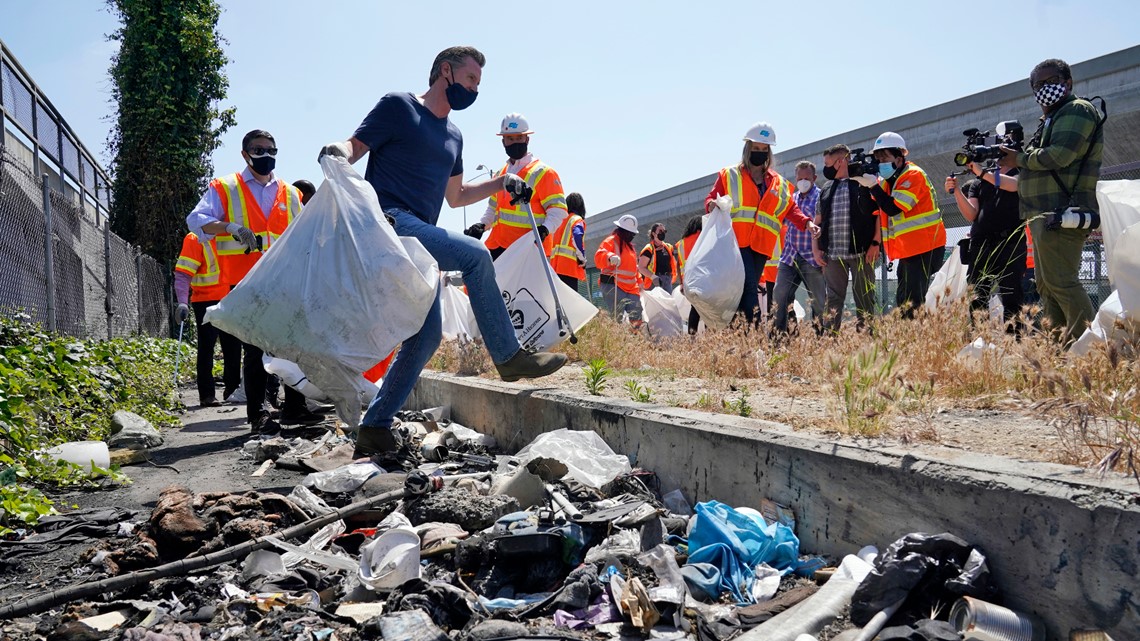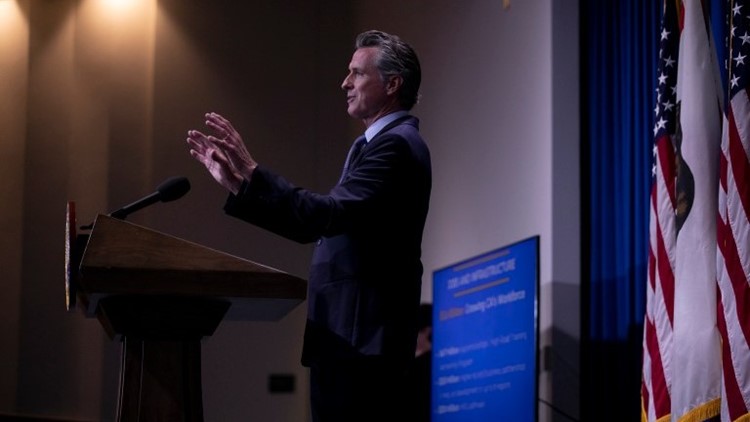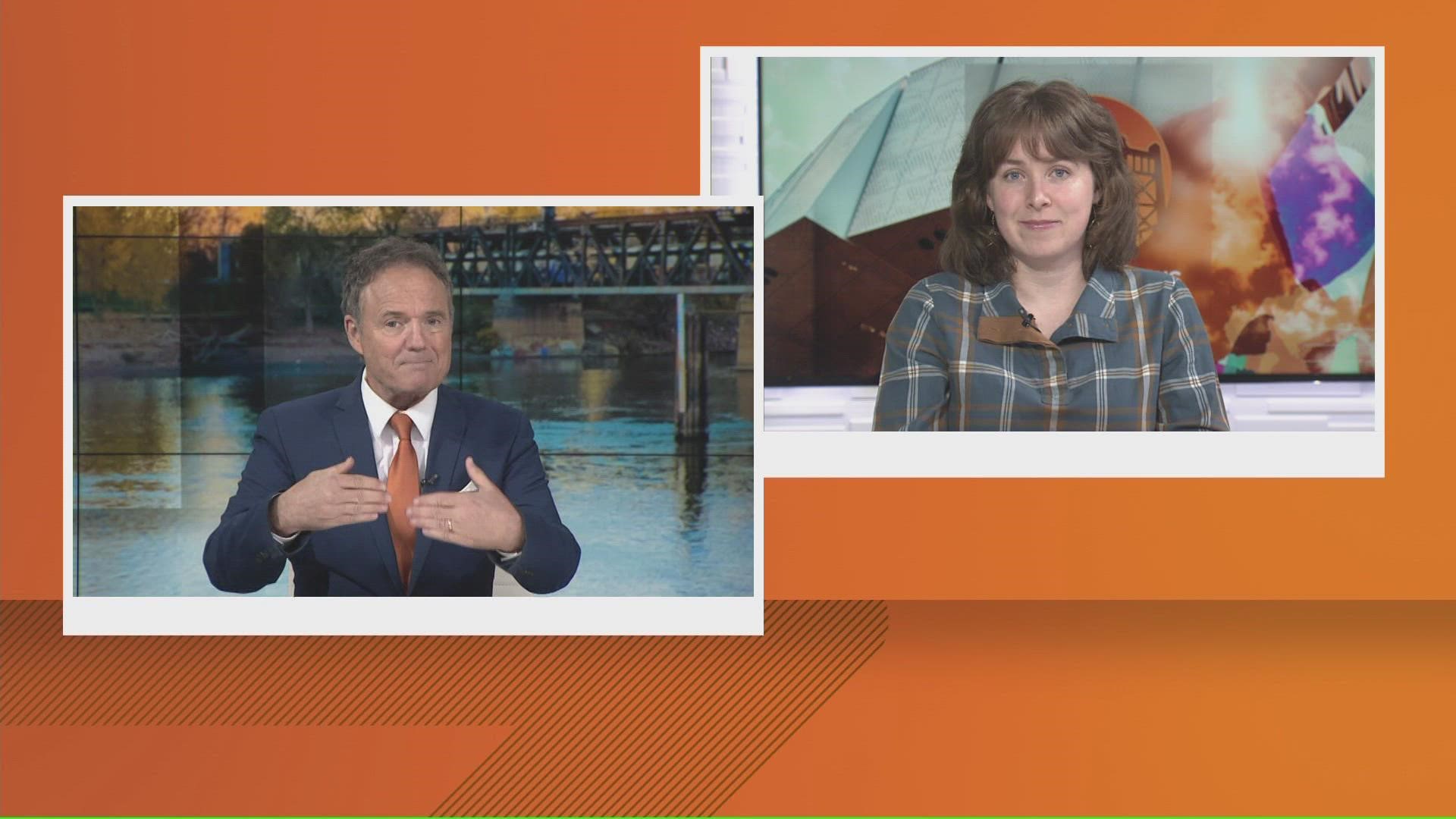CALIFORNIA, USA — This story was originally published by CalMatters.
Facing a trifecta of extraordinary circumstances — the waning COVID-19 pandemic, a looming recall election and an insanely flush state budget — Gov. Gavin Newsom barnstormed the state this week, dropping good news by the billions.
He wants to spend $12 billion to house the homeless, the governor announced in the lobby of a San Diego motel converted into a shelter; $3.4 billion to expand preschool to all 4-year-olds, he said on the playground of an elementary school in Monterey County; $1.5 billion cleaning up blight, he said as TV news crews filmed him hoisting an old mattress off the side of a Los Angeles freeway.
The announcements — capitalizing on a $76 billion surplus in the state budget plus $27 billion in federal aid — amounted to a very convenient marriage of governing and campaigning for the first-term Democrat, who almost certainly faces a Republican-led recall election this fall.
“It would be odd if he wasn’t doing this,” said Rob Stutzman, a GOP consultant who managed communications for former Gov. Arnold Schwarzenegger. “He’s got more money than he can stuff in the mattress. You get to hand it out, you get to tailor it to multiple constituencies and pretty much make everybody happy.”
It’s a strategy other governors have deployed to sell their spending priorities to voters, Stutzman said. But the specter of the looming recall — combined with the unusual hardships of the last year and the enormous windfall of money — have added some drama to what’s normally a routine step in the annual budget-making process at the Capitol.
Newsom rolled out the rest of his $267.8 billion budget proposal Friday, with a presentation that allowed him to flex his wonk muscles before heading into the final month of negotiations with lawmakers. Here are some key things to know.
Newsom is reaching out to voters who have been hit hard by the pandemic — and could be key for him to survive the recall
Trumpeting an additional $1.5 billion in grants for small businesses and $20 billion to expand preschool, summer school and afterschool programs, Newsom’s proposals seem designed to appeal to business owners and parents, groups that struggled during more than a year of on-again off-again shut-downs intended to stem the spread of the virus.
“This pandemic has not impacted all of you equally,” Newsom said in a speech Thursday to the California Chamber of Commerce. “I’m very mindful that it’s impacted, disproportionately, women.”
Newsom’s school funding proposal includes $4 billion to address behavioral health — an acknowledgment of the depression and anxiety that many children have experienced during the isolation and stress of the pandemic.
But the gusher of money may not be enough to mollify parents who are frustrated that so many California schools still have not fully reopened. Only 13% of kids are in the classroom five days a week, even though the state has among the nation’s lowest infection rates.
“There are still a lot of us who are still in a place where we are not ready to forget about what happened this year because our kids have really suffered,” said Megan Bacigalupi, an advocate with Open Schools California, whose children attend public schools in Oakland, where they go to class just five hours per week.
“Until school is back for all kids five days a week, all of this investment doesn’t really resonate.”
A recent poll shows that 83% of California public school parents think kids have fallen behind in the last year. Still, a strong majority said they approve of Newsom’s management of the schools during the pandemic.
Another constituency that can help Newsom is the powerful public employee unions, who could spend big to fight the recall. Most state worker unions agreed to a 9% pay cut last year when state officials feared a more broad-based recession at the start of the pandemic. Newsom’s plan ends the pay cut for some unions, but others are currently negotiating over it.
In his presentation, Newsom thanked state employees for taking the pay cut last year so the state didn’t have to slash services for needy Californians, and said: “You were there for us last year, we’re going to be there for you.”
But he’s also going back to early campaign promises and pre-pandemic priorities
California Republican Party chairperson Jessica Millan Patterson dubbed the governor’s events this week his “Recall Response Tour,” and said “protecting his position drives all of Gavin Newsom’s decisions.”
It’s true that he’s highlighted some issues that those who want to throw him out of office have hammered on, such as blight, homelessness and business closures.
But a closer analysis reveals that many of Newsom’s latest proposals are lifted from his pre-pandemic budgets and campaign ads. In other words, he’s trying to do what he’s long said he wanted to — now that he has the money to do it.
His proposal to give children from low-income families $500 in a college savings account builds on a smaller program he launched in 2019, which itself builds on a program he championed as San Francisco mayor. His plan to make preschool available to all 4-year-olds echoes a promise from his 2018 campaign, when he ran an ad showing a cherubic child building a tower with blocks and said he wanted to make California a place where “every toddler can attend preschool.”
Newsom’s desire to earmark an ongoing $1 billion to expand Medi-Cal health coverage to undocumented seniors ages 60 and up is similar to an idea he suggested in January 2020, but put off when the pandemic hit. The state already allows undocumented children and young adults up to age 26 to sign up for Medi-Cal, the state’s health insurance program for low-income residents. Allowing seniors to sign up would get the state closer to Newsom’s campaign promise for universal health coverage.
Newsom’s $12 billion plan to alleviate homelessness hearkens back to February 2020, when he made the issue the focus of his State-of-the-State speech and never mentioned the emerging coronavirus that would wind up derailing his plans for the year.


When Newsom campaigned for office, he pledged to build 3.5 million units of new housing by 2025. But so far the state hasn’t even come close — a point Patterson highlighted in a statement this week: “Housing costs are through the roof despite Newsom’s 2018 campaign pledge to build more housing.”
Newsom’s updated budget includes a notable boost in housing construction — but not nearly enough to reach his lofty initial goals. The biggest investment includes $1.75 billion for shovel-ready projects that would add 6,300 units of affordable housing. He also calls for $1 billion for affordable housing, the same as he proposed in January.
Newsom may not get everything he wants
Crafting a state budget is a three-way dance between the governor and the two houses of the Legislature, who will spend the next month negotiating until lawmakers pass the final spending plan in mid-June. The process always involves some give and take, even when — as has been the case for several years — all the players involved are Democrats.
“The devil is in the details,” said Democratic Assemblymember Lorena Gonzalez of San Diego. “We will end up in a similar place on expenditures, and the difference will be in the implementation and how we achieve the goal.”
Senate leader Toni Atkins, for example, proposed a new program to help first-time homebuyers. Newsom didn’t include that idea in his plan, but proposed expanding an existing homeownership assistance program. Assembly Speaker Anthony Rendon said he’ll try to increase spending on childcare and college financial aid, as well as health and social services. Key lawmakers have been pushing to overhaul of the state’s financial aid system — something Newsom didn’t include. While Newsom included $7 billion to close the digital divide, lawmakers have their own ideas about how to expand broadband service.
Various interest groups will lobby lawmakers over the next month for their share of the bounty. Some public health officials were dismayed that they didn’t get more money to make sure they’re ready for the next emergency.
“The biggest lesson of COVID-19 is that waiting until a crisis to invest in public health costs lives,” said Michelle Gibbons, executive director of the County Health Executives Association of California.
Even though Newsom proposed expanding health care and cash aid for low-income undocumented Californians, some advocates said his plan doesn’t go far enough because non-citizens have been excluded from federal stimulus checks and unemployment benefits.
“Excluded workers in California are simply asking for the same as what everyone else in California has received. We want solidarity, not charity,” said Sasha Feldstein, economic justice policy manager for California Immigrant Policy Center.
From the other end of the political spectrum, business interests will pressure Newsom and lawmakers to spend more paying down debt in the unemployment insurance fund, which is “the biggest threat to all businesses in California and their ability to bring back workers to their jobs,” according to Rob Lapsley, president of the California Business Roundtable.
Some lawmakers will undoubtedly probe Newsom’s plans to spend money over several years when the deluge of cash probably won’t last that long. The state could face a lawsuit over Newsom’s proposal to send $600 checks to Californians who make less than $75,000, with taxpayer advocates saying it may not meet the state constitution’s requirements to refund taxpayers when state revenue hits a certain threshold.
The plan essentially redistributes wealth, taking the glut of tax dollars that are largely paid by the highest earners and sending rebates to those at the middle and lower end of the income scale. Newsom said his plan was in line with Californians’ values, noting that in recent years voters have twice approved tax increases on the wealthy to fund public services. He even referenced his own status as a million-dollar-earner: “I’m proud of the fact that some of the dollars that I’m putting back into the California coffers as a taxpayer are going to help single moms out there. I’m really proud of that, and I hope others are as well.”
With the recall election still months away, another gubernatorial road show seems inevitable once the budget is passed and the money starts flowing.
CalMatters reporters Jackie Botts, Ana B. Ibarra, Barbara Feder Ostrov, Manuela Tobias and Mikhail Zinshteyn contributed to this story.
CALmatters.org is a nonprofit, nonpartisan media venture explaining California policies and politics



